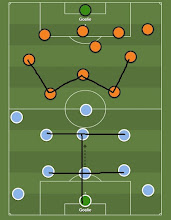Top goalkeepers who have won Olympic gold medals are extremely rare
throughout the tournament's history.
Football appears to be destined as the Olympics' secondary global tournament.
Despite its distinguished status, it is not on the FIFA international calendar.
As a result, those involved in the competition, from players to managers, are
either past their prime or have yet to become well-known. Due to the Olympics'
schedule, top players, particularly those between the sticks, are unlikely to
compete. The goalkeepers named to the squad are mostly understudies or veterans
from the senior teams. It's no surprise that only a few of them eventually
received gold medals.
The last
renowned shot stoppers to win medals at the Olympics were Mexico’s Guillermo
Ochoa and Spain’s Unai Simon. The former earned a bronze medal in the Tokyo 2020 summer Olympics after beating the host, Japan, in third place, while the
latter only received a silver medal as he was unable to help Spain defeat
Brazil in the summit.
Nevertheless,
there have always been anomalies. These are the top goalkeepers who did win
gold medals at the Olympics too. Two of them were also World Cup finalists.
Gyula Gorics (Hungary, Helsinki 1952)
The Hungarian goalkeeper was part of
the Mighty Magyars in the 1950s, when they won the Central European
Championship in 1953 and became runner-up in the 1954 FIFA World Cup. He also
featured in the 1958 and 1962 editions, although the Magyars could not replicate
their success in Switzerland in 1954.
The former Budapest Honved man was
often dubbed the pioneer of sweeper-keeping role. In the Helsinki 1952 summer
Olympics, Grosics, aged 26 at the time, also helped Hungary win their first
gold medal alongside Ferenc Puskas and Sandor Kocsis after crushing Yugoslavia
2-0 in the final. He was able to keep clean sheets in three games and defeat
Romania, Italy, Turkey, and Sweden before reaching the final.
At the club level, Grosics was the
mainstay for two local sides, Budapest Honvéd FC and Tatabanya SC. He won four
league titles. Yet he never played abroad throughout his career.
Lev Yashin (USSR, Melbourne 1956)
Grosics’ rival, Lev Yashin, also
achieved a similar accolade in Melbourne in 1956. The shot stopper, who was
still 27 years old at the time, helped the Soviet Union clinch the first gold
medal. Yet, they were forced to struggle to ease past Indonesia in the second round
after the Asian minnow held them in a stalemate. The USSR had to eliminate them
through a replay two days later, while Yashin was on the sidelines. The USSR
once again strived to see off their opposition in the semi-final, Bulgaria, in
a 2-1 win through extra time. The former Dynamo Moscow man eventually kept
clean sheets in the final with a narrow 1-0 win over Yugoslavia to snatch their
biggest prize.
The goalie, who was nicknamed ‘The
Black Spider’, played in three World Cup editions, 1958, 1962, and 1966, when
his nation reached the semi-finals. Yashin also helped the Soviet Union lift
the trophy at EURO 1960. He remains the only goalkeeper to date to have won the
Ballon d'Or, which he was awarded in 1963.
At the club level, the goalie with
74 international caps only played for one club in his playing career, Dynamo
Moscow. He was instrumental when they clinched five league titles plus three
domestic cups.
Sergio Romero (Argentina, Beijing
2008)
The Argentine goalie is the last top
figure between the sticks who won a gold medal. Romero did it in Beijing in
2008. Interestingly, he was not initially the first choice on the team. He was
only a second fiddle for Oscar Ustari. Sadly, Ustari had to be sidelined due to
his injury in the quarterfinals against the Netherlands. That was only his
second appearance in the tournament. He helped Lionel Messi and Co. see off De
Oranje and Brazil in the semifinals before thumping Nigeria in the summit. The
former Sampdoria man kept clean sheets in three out of four appearances. It was
Argentina’s second gold medal.
Romero’s career in the senior team
continued as he was the first choice for Albiceleste in two World Cup editions,
2010 and 2014. He was part of the squad in the latter when they reached the
final but lost to Germany during extra time. The current Boca Juniors man was
also an integral part of the team when Argentina lost in two consecutive Copa
America finals in 2015 and 2016.
At the club level, the 37-year-old
shot stopper was never the first in the pecking order during his stint in
Europe, except in AZ Alkmaar. However, he contributed heavily when Manchester United won the Europa League and EFL League Cup in 2017. His last appearance in
the major final was in the Copa Libertadores 2023 with Boca Juniors. Unfortunately,
they lost to Fernando Diniz’s Fluminense.



Comments
Post a Comment